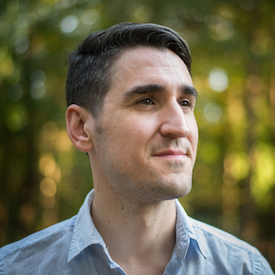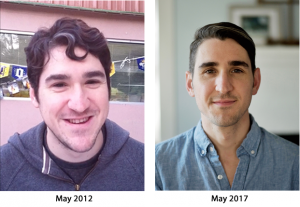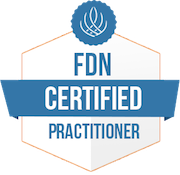MY STORY
MY STORY
My Hashimoto’s Story
In my 20s I felt defeated and broken – chronic rhinitis and sinusitis. Debilitating fatigue. Prednisone. Inhalers. IBS. Endless colds and coughs. Depression. Anti-histamines. Unexplained skin lesions…Everyday was like groundhog day – waking up each morning doomed to repeat the same story, and hoping that maybe somehow I would have enough energy to get out of bed. At best, I would wake up at 11am and get one critical task done before the day’s end. It went on like this for more than 10 years. And like many people suffering from chronic symptoms, I accepted this as the baseline for how I should feel. Symptoms were a “normal” part of life and of getting older. After all, I had never experienced true health, and therefore had nothing to compare it to. As they say, the last thing a fish would ever notice is water.
Rewinding back to my younger years, I had experienced symptoms as far back as my memory goes, with a history of frequent ear infections, strep throat, and other ENT related ailments. At various stages, I had been diagnosed with bronchitis and the croup, and later in life had invasive surgeries in my nasal cavity to “reset” (break) my septum, and to reduce the turbinates (tissue in the nasal cavity) in order to open up the airways. At 15 years old I was diagnosed with sleep apnea and had my tonsils and adenoids simultaneously removed. It was around this age that friends and family affectionately referred to me as a “bubble boy”, a limiting self image that I carried around with me for some years.
Yet, all bodily ailments aside, the most difficult part about having an undiagnosed condition was how these symptoms effected my day-to-day ability to enjoy my life, and pursue my passions. As a music school graduate, and life-long lover and performer of music, I found myself barely able to get through rehearsals or performances. In fact, the thing I looked forward to most after a gig was getting to sleep. When things were at their worst, I had given up my solo career because my sinuses were too congested for my voice to work properly. Even more so than that, I just didn’t have the energy to motivate myself, and made excuses for years for fear of looking like a hypochondriac. I felt like a prisoner to my own body.
The Food-Symptom Connection
Thankfully I was wise enough (somewhat) at a pretty young age to start establishing a correlation between my diet and symptoms (although it didn’t help much that my diet consisted of Doritos and hotdogs for so many years). As a teenager I had knife-like stabbing pains in my stomach after consuming dairy products. Having grown up in an Italian family where the two main food groups were cheese and pasta, dairy wasn’t easy to give up, but a necessary sacrifice nonetheless. From that point on, I had never experienced that intensity of stomach distress again. This represented my first step towards understanding the connection between food and wellness…
Dialing in my food sensitivities took me several years of tinkering to figure things out. My first job at 16 years old was working at a family-owned pizza restaurant, where we made our own in-house dough from high-gluten flour (the cruel irony!). For the next seven years, I maintained an on/off seasonal position around my college/gig schedule as an assistant manager where I proceeded to eat pizza nearly every night that I was working (I was sick for most of them). Some nights my allergies got so bad that I would have to leave work with clear mucous literally running down my face. It took me several years to understand that I was severely sensitive to gluten – of course I couldn’t have known that my job was literally breaking down the lining of my gut, igniting the flame for an autoimmune disease that would erupt several years later!
Circa 2006, I gave up gluten cold turkey (and the pizza cooking). At that point in time, gluten intolerance hadn’t gone mainstream, and there were very few gluten-free products on the market. And even though a blood test for celiac came back negative, I maintained a gluten-free diet simply because it alleviated so many of my symptoms. My acne cleared up in less than a month. My depression started to subside. The fog over my brain started to lift itself. I was on to something…
A Decade Of “Whack-A-Mole”
And thus began a decade long process of trial and error. In my early 20s, I had experimented with the SCD (Specific Carbohydrate Diet), after a friend had introduced me to Elaine Gottschall’s work. The ideas put forth in Breaking the Viscous Cycle – that microbial health and proper digestion were intimately tied to our health – was eye-opening and would later help to form the foundation of my functional practice. It was also Gottschall’s work that convinced me to give up gluten permanently.
Yet, despite some improvements, I had limited success with SCD. As the diet permits certain cheeses and homemade yogurt, I found myself eating dairy once again, which I believe only served to worsen my condition (I have a confirmed allergy to whey – a protein found in dairy products). In a nutritional sense, I was shooting myself in the foot.
With limited results on SCD, I moved onward to various shades of vegetarianism – exploring macrobiotics, pesca-ovatarianism, and eventually a vegan diet. The simple truth is that the benefits that I had experienced from any of these diets marginal. As much as I wanted a vegan diet to work, the condition of my health continued to spiral downward. As I would learn later, many of the staples in my diet at the time – soy, corn, peanuts, quinoa, black beans – were less than ideal for someone dealing with autoimmunity. To make make matters worse, an allergy test later in my 20s confirmed true IgE allergies to soy and peanuts, both foods that I had enjoyed in abundance as a vegan. Prior to testing, I had no knowledge that these foods were contributing to an inflammatory fire in my body that was the beginning of an underlying autoimmune process.
As my journey for symptom relief continued, I visited a specialist for each set of symptoms that I was experiencing: an allergist for my allergies, a rheumatologist for my inflammation, a dermatologist for my unexplained skin lesions, a gastroenterologist for my gut distress, a therapist for my depression, and so on – each specialist offering a treatment or prescription that would suppress the particular symptom that they were specialized in. Yet, throughout this entire process, I experienced no long-term relief. I was merely playing “whack-a-mole” with my symptoms.
Around this same time – after visiting a dermatologist that was puzzled over my constellation of symptoms – I was recommended to be a test patient at a “Grand Rounds” at Yale New Haven Hospital. The idea here was that budding med students might take a crack at unraveling my seemingly unrelated set of mystery symptoms. Finally, I thought, I might get some answers…
I was seen by 40 medical professionals that day, and they came back with nothing – not even an inkling or suggestion for how to proceed. I was still nearly a decade away from receiving a diagnosis.
The Functional Model
Now, I’m not bashing the conventional medical model. If I were to break my arm, or to have a heart attack, I would like to be driven to the emergency room, not the herbalist. But it should be pointed out that at no point did any doctor recommend therapeutic diets, exercise, or meditation, nor were they able to recognize my seemingly disparate symptoms as being interconnected in any way.
Having been trained in the functional model, it is clear to me that Western medicine is not equipped to deal with or understand the root causes of chronic symptoms and disease. While the allopathic model may offer drugs and surgery to suppress symptoms, the underlying cause will continue to become progressively worse beneath the surface. By contrast, the functional model states that the root cause is almost always far removed from the symptom that is actually presenting itself. What doctors and specialists failed to see in my 20s is how all of these “unrelated” symptoms could actually be traced back to the same source, if only they had thought to look upstream.
At this stage, I was convinced that something “underlying” was yet to to be uncovered, and was determined to find out just what that was. In a last ditch effort, I managed to find a doctor in my area that was licensed in both Western and Chinese medicine (and nearly begged him for answers). After running some tests, blood work confirmed that I was living with Hashimoto’s Thyroiditis, an autoimmune disease in which the immune system mounts an attack on the thyroid. In addition to having elevated auto-antibodies to the thyroid, my TSH was above the lab range – a value greater than 150 (not a typo!), meaning that my pituitary gland was screaming at my thyroid to produce thyroid hormone. While in a sense disheartening, having a diagnosis felt like a huge weight was being lifted off of my shoulders. There was finally something concrete to point to all of my symptoms. It wasn’t all “in my head” as so many of us with thyroid disorders are told in the years leading up to diagnosis.
Day one after starting medication for thyroid hormone replacement, I woke up the next morning at 7:00 am for the first time in over decade without three alarms going off at once. I’ll never forget an experience that I had running into a dear friend and former bandmate after less than one week on thyroid medication. Barely recognizing this new person a with a smile on their face and a spring in their step, he shouted out, “WHOA! What did you do with Ryan!?”
(The picture to the left was the day I received my Hashimoto’s diagnosis. To the right, five years being on the right thyroid medication, adhering to an Autoimmune Protocol, addressing nutrient deficiencies, adjusting my lifestyle to reduce stress, improving the quality of my sleep, and ridding my body of toxins and infections).
I Am Not My Diagnosis
Looking back, it felt like I lost a decade or more of my life to fatigue, depression, and general malaise. The truth is, it’s easy for my mind to go to a place where I mourn lost time, opportunity, connection, and perhaps even an unwritten album. But, had I not been through so much physiological suffering, I wouldn’t have the knowledge that I do now to heal myself, educate others, and to start again. Having experienced disease for so many years created a drive and determination in me to reverse engineer the mechanisms that drive physiological dysfunction in the body, and to understand what can be done about it from a practical perspective. I was empowered to become more than my diagnosis.
That first step that led me down the healing path was discovering the Autoimmune Protocol, an ancestral approach that focuses on nutrient-density, in addition to foods that build and repair the gut. These foods were once enjoyed in abundance by traditional societies, and before the advent of many Western diseases. Sadly, many of these foods – grass fed beef, liver, bone broth, sauerkraut – are almost entirely missing from the Standard American Diet despite their nutrient-density. As the prevailing theory in the functional community points towards intestinal permeability (leaky gut) as a prerequisite for developing autoimmunity, AIP provides hope for many to reverse the autoimmune process by improving conditions in the gut. Discovering AIP has been an integral part of my own symptom management and healing process, and the first time in my life where I had felt – on a visceral level – that my body was actually getting what it needed.
And while I believe that a nutrient-dense approach should be THE cornerstone of any holistic program of self-treatment, it also became clear to me that diet by itself would not restore my body to normal function. As I continued to heal and repair my body with nutrient-dense foods, the functional model helped me to understand that I was dealing with “hidden” chronic stressors that were preventing my body from healing. Functional lab work later revealed that I was living with multiple gut infections (Blastocystis Hominis, H. Pylori, Candida), food sensitivities, HPA Axis dysregulation, viral activity, and an MTHFR defect that were all contributing to the autoimmune process. Of these interventions, ridding my gut of infections with nutraceuticals and targeted supplements helped me to reduce my chronic allergy symptoms by about 80%! It was by addressing these issues one by one, that I have been able to make enormous strides towards managing the symptoms of Hashimoto’s, and ultimately, towards living a fulfilling life.
I truly believe that Hashimoto’s has been my greatest gift and teacher, and this is what it has taught me – nothing is more important than our own health. It is the foundation upon which everything else rests, and therefore, the greatest investment anyone could make in themselves. As the saying goes, “first we eat, and then we do everything else”. It is hard to imagine any form of success, whether it be with one’s career, finances, relational, or spiritual goals – without first being sound in mind and body. I hope this encourages you to seek health in your own life, so that you may flourish and experience life to your fullest potential.
Today, my music career is thriving more than it ever has as I continue to work with clients in-between time on the road. As I look towards that future with my renewed health, I believe that I’m only at the beginning of that journey.
To Health,
Ryan Monahan, FDN-P, NBC-HWC
Ryan@18.190.2.118

Ryan Monahan, FDN-P, NBC-HWC
The Mindful Nutrivore
Ryan Monahan is a “health detective” residing outside of Boulder, CO with a passion for uncovering the hidden stressors that contribute to thyroid malfunction. Ryan spent over 10 years visiting more than 40 health professionals to find answers to his chronic health complaints until being diagnosed with Hashimoto’s in 2012. His mission is to change the dialogue about chronic disease towards a holistic, functional approach.



